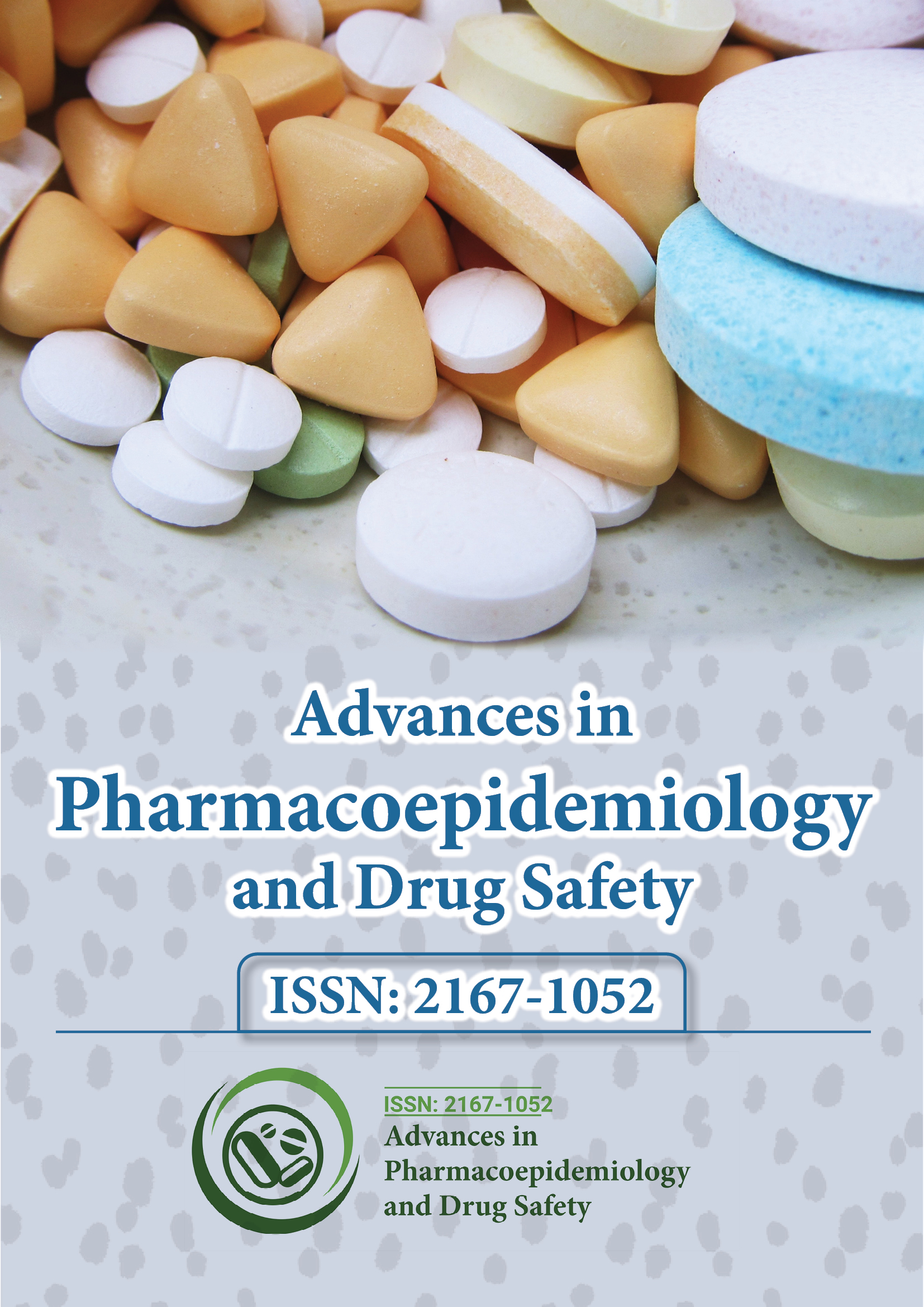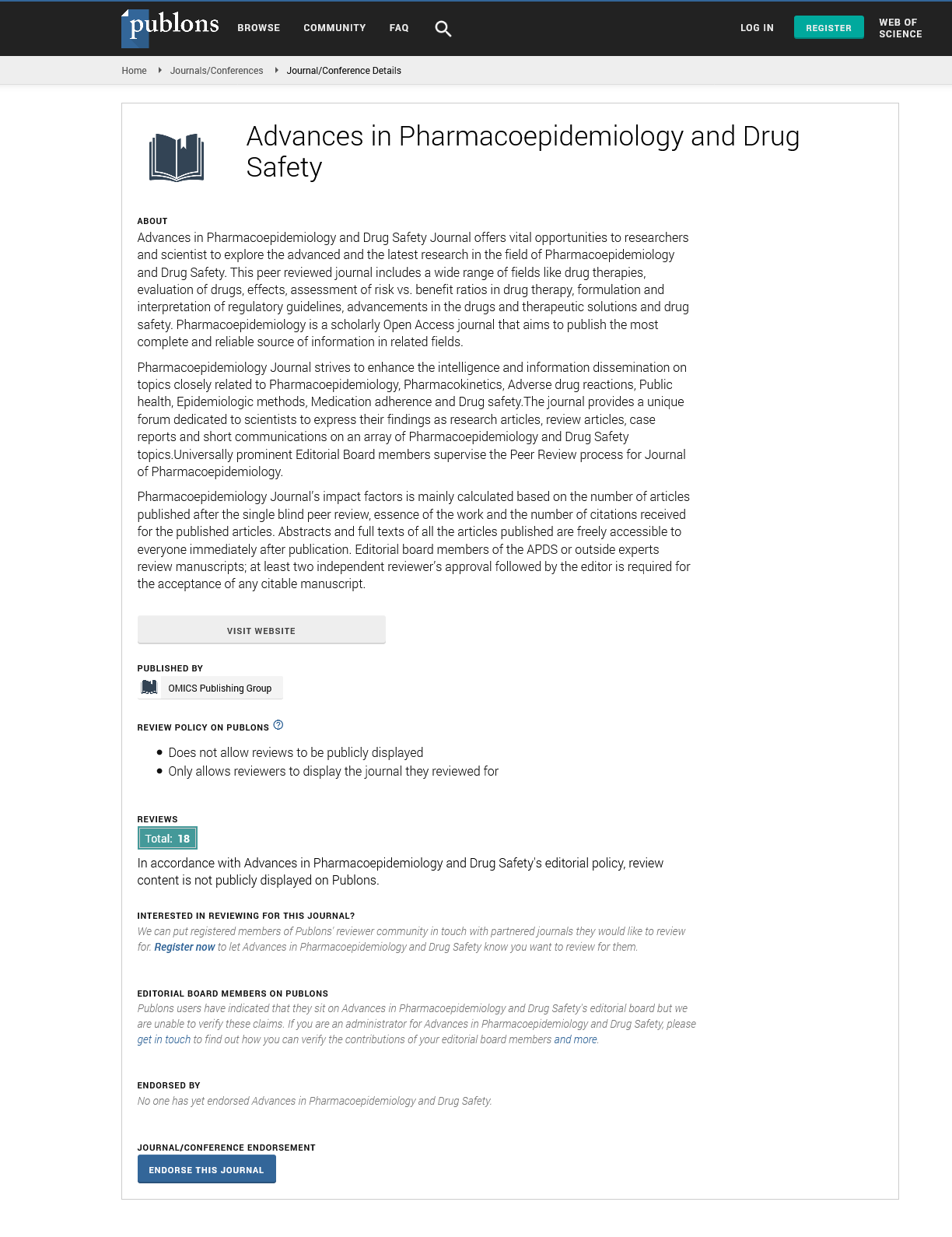Indexed In
- Open J Gate
- Genamics JournalSeek
- Academic Keys
- JournalTOCs
- RefSeek
- Hamdard University
- EBSCO A-Z
- SWB online catalog
- Publons
- Geneva Foundation for Medical Education and Research
- Euro Pub
- Google Scholar
Useful Links
Share This Page
Journal Flyer

Open Access Journals
- Agri and Aquaculture
- Biochemistry
- Bioinformatics & Systems Biology
- Business & Management
- Chemistry
- Clinical Sciences
- Engineering
- Food & Nutrition
- General Science
- Genetics & Molecular Biology
- Immunology & Microbiology
- Medical Sciences
- Neuroscience & Psychology
- Nursing & Health Care
- Pharmaceutical Sciences
Short Communication - (2025) Volume 14, Issue 2
Evolving Perspectives in Pharmacoepidemiology and Drug Safety
Lucas Reinhardt*Received: 29-May-2025, Manuscript No. PDS-25-29844; Editor assigned: 31-May-2025, Pre QC No. PDS-25-29844; Reviewed: 14-Jun-2025, QC No. PDS-25-29844; Revised: 20-Jun-2025, Manuscript No. PDS-25-29844; Published: 28-Jun-2025, DOI: 10.35248/2167-1052.25.14.391
Description
Pharmacoepidemiology has emerged as an essential field for understanding how medicines perform in large populations and how their safety can be assured over time. Clinical trials often provide controlled information on efficacy and safety but real world practice reveals broader patterns that cannot be captured in early phase research. As populations age and therapeutic choices expand it has become increasingly important to track medication usage adverse effects and interactions across different demographic groups. The growth of electronic health records and data registries has given researchers access to large scale information that can be analyzed to detect safety signals early and to refine guidelines for rational prescribing [1]. Drug safety remains one of the most important challenges in public health since adverse reactions continue to rank among leading causes of hospitalization. Pharmacoepidemiology brings together clinical medicine pharmacology statistics and public health principles to reduce risks associated with drug use. By applying observational study designs researchers can examine associations between medications and long term outcomes in diverse patient populations. This evidence informs regulators and clinicians about unexpected reactions or benefits and helps guide post marketing surveillance [2].
One notable advancement is the application of data mining methods that scan large health care databases for potential safety issues. These methods can identify patterns that suggest increased risk for certain adverse effects which can then be validated with further studies. Pharmacoepidemiology also benefits from international collaborations where researchers in different countries compare findings and establish global safety networks. Such collaboration ensures that signals detected in one population can be evaluated elsewhere to confirm their validity and relevance [3]. Drug safety evaluation extends beyond prescription drugs into the area of biologics vaccines and over the counter medications. The rapid development of biologic therapies has created both opportunities and new safety considerations. Post marketing evaluation helps to determine how these complex agents perform in populations with varied genetic backgrounds and comorbidities. Vaccines provide another important example where pharmacoepidemiology has been used to monitor rare adverse events and to maintain public confidence in immunization programs [4].
Pharmacoepidemiology also has an important role in evaluating medication adherence and persistence. Even the most effective therapy cannot achieve optimal outcomes if patients discontinue treatment early or fail to take medicines consistently [5]. By analyzing adherence patterns and associated outcomes researchers can provide evidence for interventions that support patient behavior and improve long term effectiveness. Digital health tools mobile applications and pharmacy refill data are being integrated into research strategies to give clearer insights into real world medication use. Another advancement is the use of genetic and molecular information to refine pharmacoepidemiologic studies [6].
Pharmacogenomic data can explain why certain individuals are more susceptible to adverse reactions or why some groups respond differently to the same therapy. By integrating molecular information with population based studies researchers are moving closer to developing safer and more effective prescribing strategies for diverse communities. International agencies have increasingly adopted pharmacoepidemiologic findings to shape regulatory decisions [7]. Post marketing commitments for pharmaceutical companies often require long term safety studies that rely on population data. National registries and insurance claims data play an essential role in fulfilling these commitments. Governments and health systems also benefit from pharmacoepidemiology since the findings help allocate resources reduce avoidable hospitalizations and ensure more rational medication policies [8].
As health systems continue to digitalize the availability of real world data will expand further. Advanced computing power will allow researchers to process larger datasets in shorter time frames providing timely evidence for safety monitoring. However, challenges remain in ensuring data quality patient privacy and appropriate statistical analysis. Ethical considerations also continue to guide how information is collected stored and shared for research [9]. Overall pharmacoepidemiology and drug safety research are advancing through integration of large scale data analytics genetics international collaboration and digital health technology. These efforts are improving the ability to detect adverse effects early evaluate medication effectiveness in practice and support better outcomes for patients worldwide. The field continues to expand in scope as new therapies emerge and as populations demand safer and more effective medicines [10].
References
- Bo L, Wang Y, Li Y, Wurpel JN, Huang Z, Chen ZS. The battlefield of chemotherapy in pediatric cancers. Cancers. 2023;15(7):1963.
[Crossref] [Google Scholar] [PubMed].
- Yeh ML, Chang YJ, Yeh SJ, Huang LJ, Yen YT, Wang PY, et al. Potential drug–drug interactions in pediatric outpatient prescriptions for newborns and infants. Comput. Methods Programs Biomed. 2014;113(1):15-22.
[Crossref] [Google Scholar] [PubMed].
- Hadjibabaie M, Badri S, Ataei S, Moslehi AH, Karimzadeh I, et al. Potential drug-drug interactions at a referral hematology-oncology ward in Iran: A cross-sectional study. Cancer Chemother Pharmacol. 2013;71(6):1619-1627.
[Crossref] [Google Scholar] [PubMed].
- Daignault C, Sauer HE, Lindsay H, Alonzo A, Foster J. Investigating potential drug-drug interactions in pediatric and adolescent patients receiving chemotherapy. J Oncol Pharm Pract. 2022;28(4):904-909.
[Crossref] [Google Scholar] [PubMed].
- Testoni I, Nicoletti AE, Moscato M, De Vincenzo C. A qualitative analysis of the experiences of young patients and caregivers confronting pediatric and adolescent oncology diagnosis. Int J Environ Res Public Health. 2023;20(14):6327.
[Crossref] [Google Scholar] [PubMed].
- Pickering G, Loriot MA, Libert F, Eschalier A, Beaune P, Dubray C. Analgesic effect of acetaminophen in humans: First evidence of a central serotonergic mechanism. Clin Pharmacol Ther. 2006;79(4):371-8.
[Crossref] [Google Scholar] [PubMed].
- Choi YH, Lee IH, Yang M, Cho YS, Jo YH, Bae HJ, et al. Clinical significance of potential drug–drug interactions in a pediatric intensive care unit: A single-center retrospective study. PLoS One. 2021;16(2):0246754.
[Crossref] [Google Scholar] [PubMed].
- Horace AE, Ahmed F. Polypharmacy in pediatric patients and opportunities for pharmacists’ involvement. Integr pharm res pract 2015:113-126.
[Crossref] [Google Scholar] [PubMed].
- Fraser LK, Gibson-Smith D, Jarvis S, Papworth A, Neefjes V, et al. Polypharmacy in children and young people with life-limiting conditions from 2000 to 2015: A repeated cross-sectional study in England. J Pain Symptom Manage. 2022;64(3):213-221.
[Crossref] [Google Scholar] [PubMed].
- Zhu K, Yang X, Tai H, Zhong X, Luo T, Zheng H. HER2-targeted therapies in cancer: A systematic review. Biomark Res. 2024;12(1):16.
[Crossref] [Google Scholar] [PubMed].
Citation: Reinhardt L (2025). Evolving Perspectives in Pharmacoepidemiology and Drug Safety. J Adv Pharmacoepidemiol Drug Saf. 14:391
Copyright: © 2025 Reinhardt L. This is an open access article distributed under the terms of the Creative Commons Attribution License, which permits unrestricted use, distribution, and reproduction in any medium, provided the original author and source are credited.

